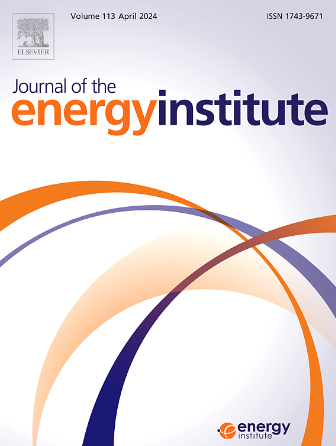东明褐煤热溶液化油在Co-CoNx@C650上催化加氢精制成富环烷液体燃料
IF 6.2
2区 工程技术
Q2 ENERGY & FUELS
引用次数: 0
摘要
低品位褐煤液化油加氢精制成高密度液体燃料是其增值利用的重要途径。然而,这类原油中含有丰富的缩合芳环(ARs)和O原子,这给二次升级带来了重大挑战,特别是如何在一锅中同时实现AR加氢和加氢脱氧以生产烷基环烷。鉴于此,采用原位共热解+ NH3硝化的级联制备策略构建Co-CoNx@C650。它具有高度分散的Co-CoNx双位点和含有丰富缺陷/空位的碳底物,在AR加氢和加氢脱氧中表现出良好的性能。此外,该催化剂能有效活化H2,促进H··H、δ+H··Hδ−和H·的协同转移。它具有良好的接近性、循环稳定性和可再生性,适用于萘-2-醇、芳醚等大中型分子加氢成环烷。东明褐煤正己烷热溶液化油(SPTD)富含芳烃(76.1%),Co-CoNx@C650催化加氢精制成品油(CHSPTD)富含饱和烃(91.7%),尤其是烷基环烷(69.8%)。Co-CoNx@C650所证明的芳烃含氧部分的高效转化为将低品位褐煤液化油转化为富含环烷的高附加值液体燃料提供了新的解决方案。本文章由计算机程序翻译,如有差异,请以英文原文为准。

Catalytic hydrofining of thermal dissolution-derived liquefied oil from Dongming lignite into cyclanes-rich liquid fuel over Co-CoNx@C650
Hydrofining of low-grade lignite liquefied oils into high-density liquid fuels is a critical pathway for their value-added utilization. However, abundant condensed aromatic rings (ARs) and O atoms in such crude oils pose significant challenges for secondary upgrading, particularly in achieving concurrent AR hydrogenation and hydrodeoxygenation in one-pot to produce alkyl cyclanes. In view of this, Co-CoNx@C650 was constructed by a cascade preparation strategy consisting of in-situ co-pyrolysis and NH3 nitridation. It has highly dispersed Co-CoNx dual-sites and carbon substrate with abundant defects/vacancies, and exhibits good performance in AR hydrogenation and hydrodeoxygenation. In addition, this catalyst can effectively activate H2 and promote the synergistic transfer of H···H, δ+H···Hδ−, and H·. Good accessibility, cyclic stability, and renewability make it suitable for the hydrogenation of medium/large-sized molecules such as naphth-2-ol and aryl ethers into cyclanes. The liquefied oil (SPTD) from Dongming lignite thermal dissolution in n-hexane is rich in aromatics (76.1 %), while refined oil (CHSPTD) from catalytic hydrofining over Co-CoNx@C650 is rich in saturated hydrocarbons (91.7 %), especially alkyl cyclanes (69.8 %). The efficient conversion of aromatic-oxygenated moieties demonstrated by Co-CoNx@C650 provides a new solution for converting low-grade lignite liquefied oils into value-added cyclanes-rich liquid fuels.
求助全文
通过发布文献求助,成功后即可免费获取论文全文。
去求助
来源期刊

Journal of The Energy Institute
工程技术-能源与燃料
CiteScore
10.60
自引率
5.30%
发文量
166
审稿时长
16 days
期刊介绍:
The Journal of the Energy Institute provides peer reviewed coverage of original high quality research on energy, engineering and technology.The coverage is broad and the main areas of interest include:
Combustion engineering and associated technologies; process heating; power generation; engines and propulsion; emissions and environmental pollution control; clean coal technologies; carbon abatement technologies
Emissions and environmental pollution control; safety and hazards;
Clean coal technologies; carbon abatement technologies, including carbon capture and storage, CCS;
Petroleum engineering and fuel quality, including storage and transport
Alternative energy sources; biomass utilisation and biomass conversion technologies; energy from waste, incineration and recycling
Energy conversion, energy recovery and energy efficiency; space heating, fuel cells, heat pumps and cooling systems
Energy storage
The journal''s coverage reflects changes in energy technology that result from the transition to more efficient energy production and end use together with reduced carbon emission.
 求助内容:
求助内容: 应助结果提醒方式:
应助结果提醒方式:


